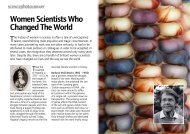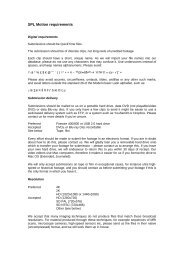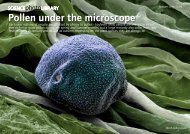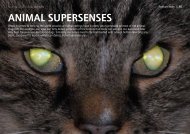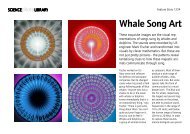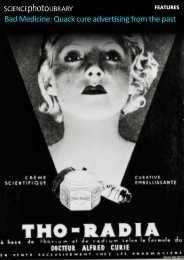Seeing Insects In A New Light - Science Photo Library
Seeing Insects In A New Light - Science Photo Library
Seeing Insects In A New Light - Science Photo Library
Create successful ePaper yourself
Turn your PDF publications into a flip-book with our unique Google optimized e-Paper software.
<strong>Seeing</strong> <strong><strong>In</strong>sects</strong><br />
<strong>In</strong> A <strong>New</strong> <strong>Light</strong><br />
Small flies and wasps were recently discovered to<br />
display colourful wing patterns known as ‘wing<br />
interference patterns’.
<strong>Science</strong> <strong>Photo</strong> <strong>Library</strong> Feature Stories<br />
For centuries,<br />
biologists around<br />
the world have<br />
collected and identified<br />
thousands of<br />
species of small flies<br />
and wasps. The usual<br />
procedure is to collect<br />
samples from the<br />
wild, preserve them<br />
in alcohol, stick them<br />
onto white card and<br />
examine them under<br />
the microscope. It’s<br />
not an easy task due<br />
to the insects’ tiny<br />
proportions and fragile<br />
nature. But until<br />
recently, one glaringly<br />
obvious aspect has<br />
been entirely overlooked<br />
– they all have<br />
brightly coloured wing<br />
patterns.<br />
Scientists at Lund University<br />
in Sweden and<br />
University of Pennsylvania<br />
noticed that<br />
apparently transparent<br />
fly and wasp wings examined<br />
under a microscope<br />
against a black<br />
background revealed<br />
distinctive patterns of<br />
multicoloured spots,<br />
stripes and bands. It<br />
seems that these iridescent<br />
patterns were<br />
not noticed previously<br />
due to the laboratory<br />
standard of viewing<br />
specimens against a<br />
white background.<br />
“Given favorable light<br />
conditions, they display<br />
a world of brightly<br />
patterned wings<br />
that are apparently<br />
unnoticed by contemporary<br />
biologists,” says<br />
University of Lund entomologist<br />
Ekaterina<br />
Shevtsova.<br />
The patterns are not<br />
just random ‘soap bubble’<br />
reflections, say the<br />
researchers, but seem
to be stable and serve a function<br />
for the insects, possibly in<br />
a similar way that butterflies,<br />
moths and beetles display colourful<br />
signals on their bodies.<br />
Although the patterns are visible<br />
to the naked eye, they are<br />
particularly vivid when viewed<br />
by insects, which have eyes<br />
that detect ultraviolet, red and<br />
green instead of the blue, red<br />
and green that most humans<br />
see.<br />
Excited by this discovery,<br />
entomologists are now reexamining<br />
other transparent<br />
winged insects such as<br />
dragonflies, cockroaches and<br />
grasshoppers to see more<br />
undiscovered iridescent wing<br />
patterns.<br />
ENDS 270 WDS © COPY-<br />
RIGHT 2011 SCIENCE PHOTO<br />
LIBRARY
FULL PICTURE SET<br />
For captions and credits, please refer to the captions.txt file<br />
<strong>Science</strong> <strong>Photo</strong> <strong>Library</strong> Feature Stories<br />
For further information, please contact: seymour@sciencephoto.com<br />
All images are copyright, please credit images as stated on the captions



